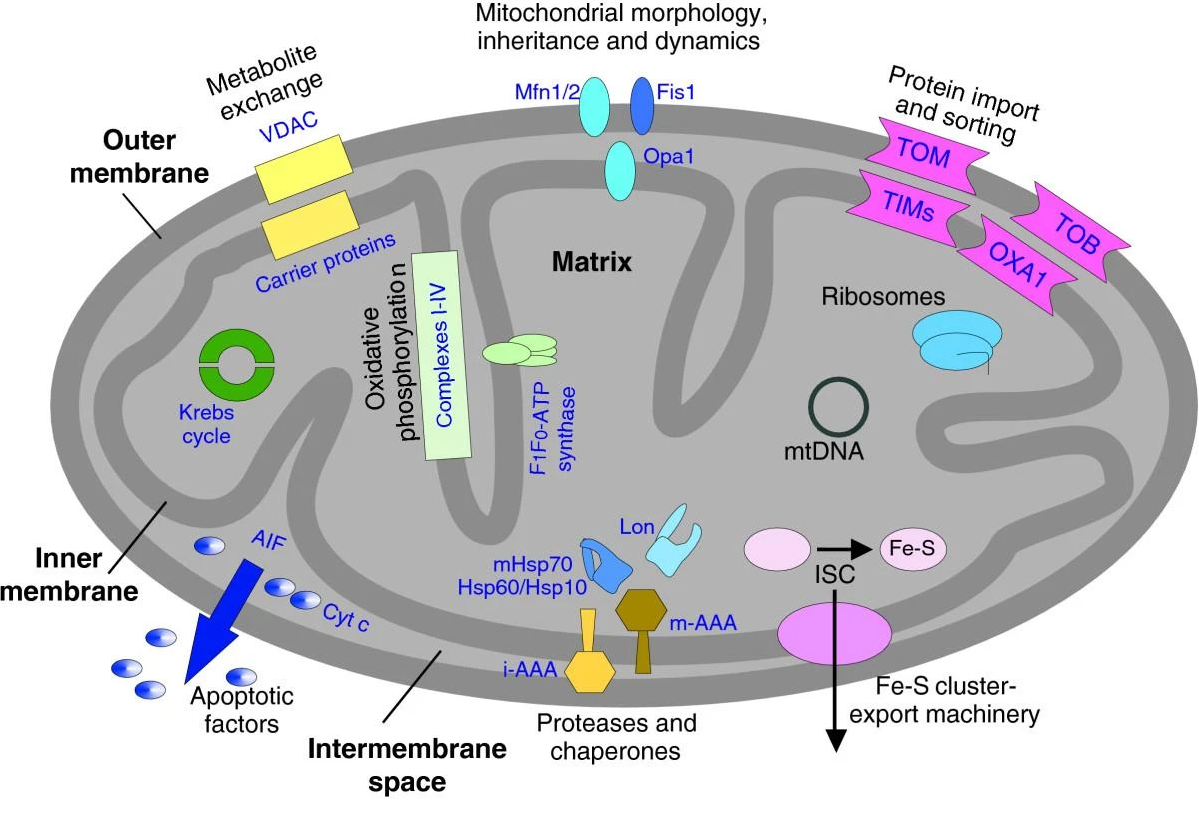Mitochondrial Proteomics Services
Mitochondria are the powerhouses of the cell, involved in essential physiological processes such as cellular respiration, energy production, metabolic regulation, and apoptosis. Mitochondrial proteomics analysis focuses on the study of the mitochondrial proteome, aiming to reveal the crucial roles of mitochondria in cellular function, energy metabolism, and disease mechanisms. This service employs high-resolution mass spectrometry to perform comprehensive qualitative and quantitative analysis of mitochondrial proteins. Combined with mitochondrial isolation and enrichment techniques, it enables precise profiling of protein composition, post-translational modifications, and their alterations under various physiological or pathological conditions.
Mitochondrial proteomics services are widely applied in the fields of metabolic diseases, neurodegenerative disorders, cancer research, aging, and immunology. By studying the mitochondrial proteome, researchers can gain deep insights into the key roles of mitochondria in cellular energy metabolism, redox balance, apoptosis, and signal transduction, thereby providing valuable data for exploring disease mechanisms and identifying novel drug targets.

Dimmer, K S. et al. Genome Biology, 2008.
Figure1. Overview of Mitochondria-Related Processes.
Services at MtoZ Biolabs
Based on high-resolution mass spectrometry platforms, the mitochondrial proteomics services offered by MtoZ Biolabs focus on the comprehensive study of the mitochondrial proteome. This service integrates mitochondrial isolation and enrichment techniques to ensure efficient extraction and analysis of mitochondrial proteins. Through precise qualitative and quantitative analysis, it reveals information on protein composition, abundance changes, and post-translational modifications. Clients receive high-throughput data that support functional studies of mitochondria in biological processes such as cellular energy metabolism, redox balance, and apoptosis, as well as research in areas including metabolic diseases and neurodegenerative disorders.

Baker, Z N. et al. Nature Reviews Molecular Cell Biology, 2024.
Figure 2. Potential Sources of Mitochondrial Proteins.
Analysis Workflow
1. Mitochondrial Isolation and Enrichment
Mitochondria are isolated and enriched from cells or tissues using differential centrifugation to ensure high-purity mitochondrial fractions.
2. Protein Extraction and Digestion
Mitochondrial proteins are extracted using appropriate buffers and enzymatically digested to generate peptides suitable for mass spectrometry analysis.
3. Mass Spectrometry Analysis
High-resolution LC-MS/MS platforms are used to perform qualitative and quantitative analysis of digested samples, identifying the types and abundances of mitochondrial proteins.
4. Data Analysis and Functional Annotation
Bioinformatics tools are applied for protein functional annotation, pathway analysis, and post-translational modification analysis to uncover functional changes of mitochondrial proteins under different physiological or pathological conditions.
Sample Submission Suggestions
1. Sample Types
Applicable to animal cells, tissues, and mitochondrial-enriched fractions. It is recommended to provide a sufficient amount of sample to ensure efficient extraction of mitochondrial proteins.
2. Sample Handling
Samples should be protected from repeated freeze-thaw cycles and are recommended to be stored fresh or snap-frozen. If preliminary processing (such as mitochondrial isolation) has been performed, please provide the relevant information.
3. Sample Transportation
Samples should be stored at -80°C and shipped on dry ice to maintain low temperatures throughout transport and prevent protein degradation. For protein extracts, please specify the buffer composition and protein concentration.
Service Advantages
1. High-Purity Mitochondrial Isolation
Optimized isolation methods ensure high-purity mitochondrial samples, avoiding intracellular contamination and ensuring the accuracy of protein analysis.
2. High-Throughput and High-Sensitivity Analysis
Based on high-resolution mass spectrometry platforms, the service enables precise identification and quantification of low-abundance mitochondrial proteins, suitable for complex sample analysis.
3. Comprehensive Data Analysis and Functional Annotation
Provides protein identification, quantification, functional annotation, and pathway enrichment analysis to support in-depth understanding of mitochondrial roles in energy metabolism, redox balance, and other processes.
4. Customized Services
Offers personalized service solutions tailored to different research needs, supporting various sample types, processing conditions, and data analysis strategies to meet specific requirements across different research fields.
Applications
1. Metabolic Disease Research
By analyzing functional changes in mitochondrial proteins, this service helps elucidate mitochondrial dysfunction mechanisms in metabolic diseases such as diabetes and obesity.
2. Neurodegenerative Disease Research
Mitochondrial proteomics services can be used to explore the roles of mitochondrial proteins in neurodegenerative diseases such as Alzheimer’s and Parkinson’s disease, revealing pathological mechanisms and potential therapeutic targets.
3. Cancer Research
By examining the expression and functional alterations of mitochondrial proteins, researchers can investigate mitochondrial adaptation in tumor cells and identify novel cancer biomarkers.
4. Aging Mechanism Studies
Mitochondrial proteomics services can be applied to study functional changes of mitochondria during aging, providing a theoretical basis for early diagnosis and intervention of age-related diseases.
FAQ
Q1: Is it Possible to Extract Mitochondrial Proteins from Frozen Samples?
A1: Yes, frozen samples are acceptable. However, to ensure the stability and activity of mitochondrial proteins, we recommend storing samples at -80°C and avoiding repeated freeze-thaw cycles. If you are submitting frozen samples, please inform us in advance so we can apply appropriate sample handling procedures.
Q2: Can Low-Abundance Mitochondrial Proteins Be Quantitatively Analyzed?
A2: Yes. We utilize high-resolution mass spectrometry platforms (such as Orbitrap LC-MS/MS) to accurately identify and quantify low-abundance mitochondrial proteins, ensuring the reliable detection of protein complexes and intracellular molecules in complex samples.
Deliverables
1. Comprehensive Experimental Details
2. Materials, Instruments, and Methods
3. Data Analysis, Preprocessing, and Estimation
4. Bioinformatics Analysis
5. Raw Data Files
How to order?







